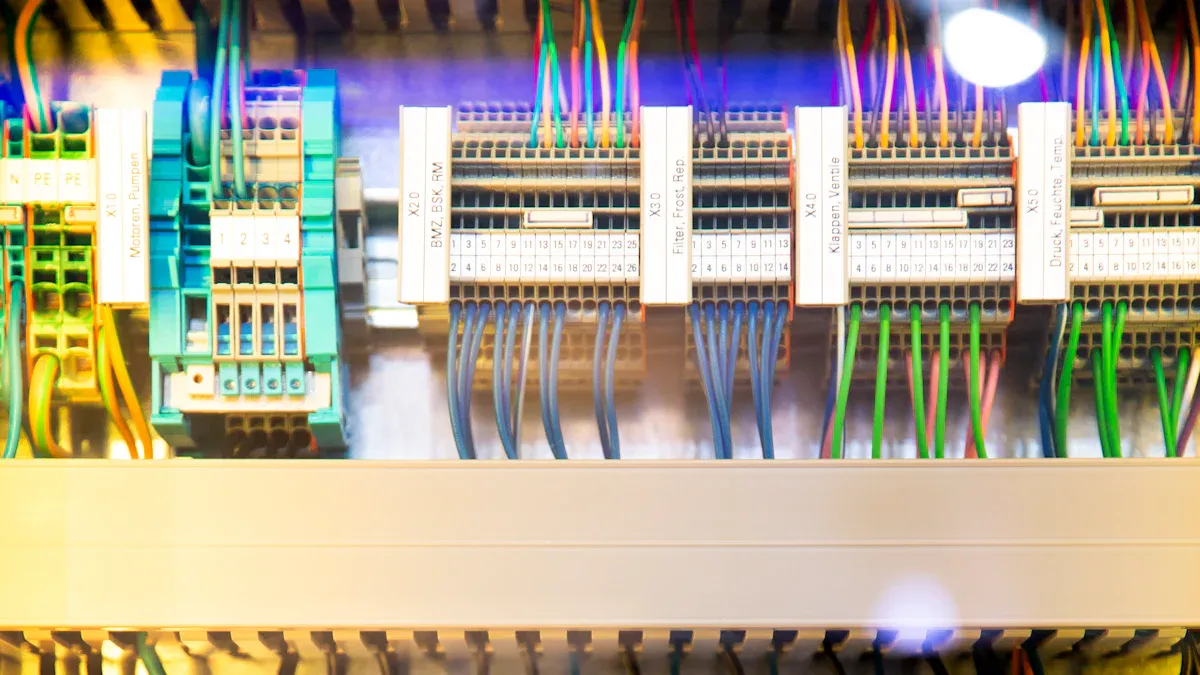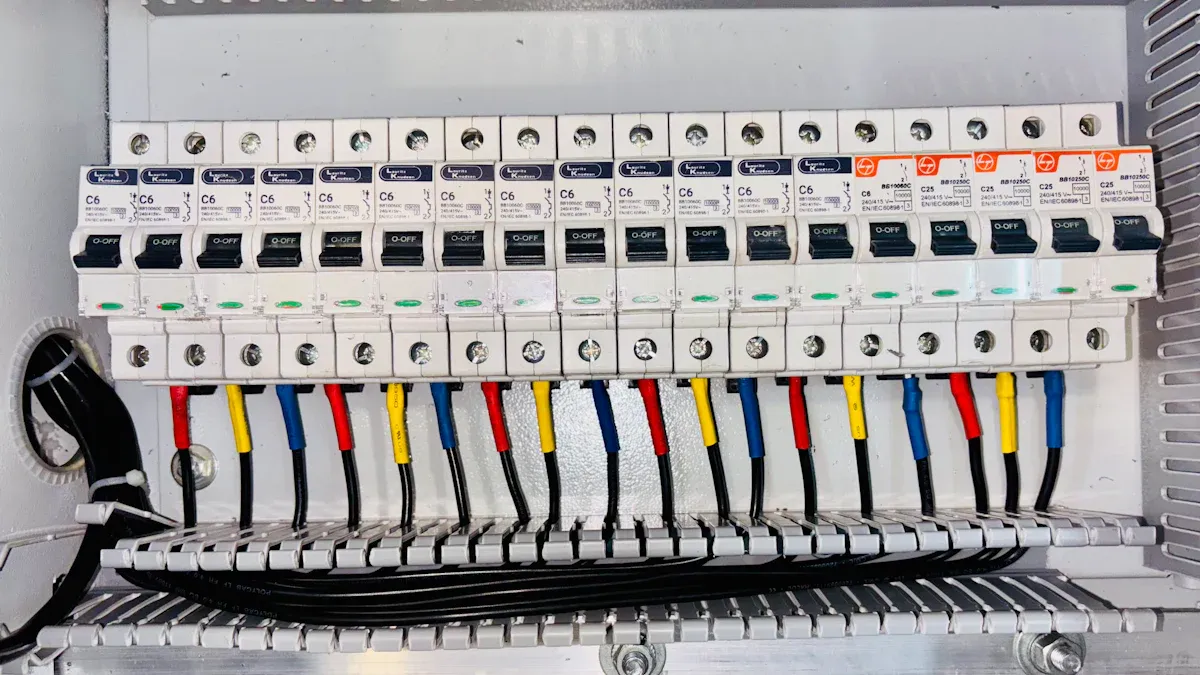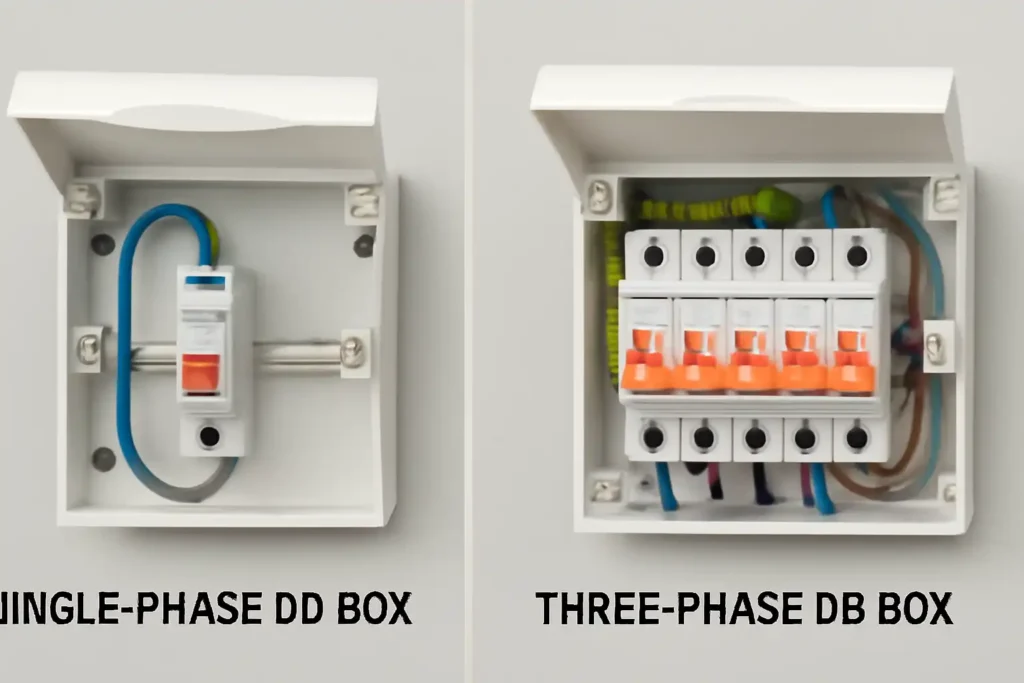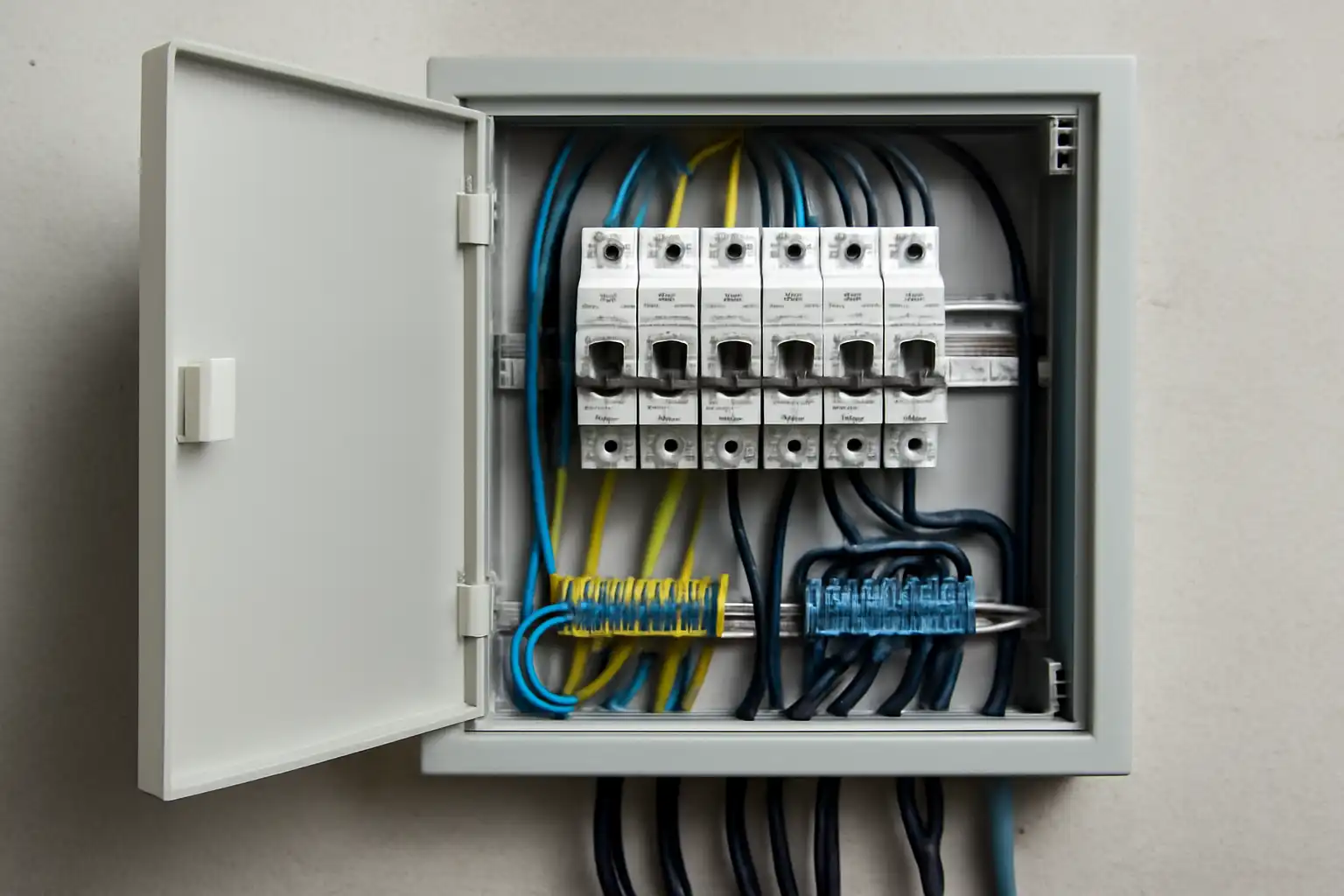When dealing with electricity, you may encounter single-phase and three-phase DB boxes. Single-phase and three-phase DB boxes are designed for different power requirements—single-phase DB boxes are ideal for smaller power demands, such as homes or small devices, while three-phase DB boxes are better suited for distributing power efficiently in larger systems, like factories or commercial businesses.
Understanding the distinction between single-phase and three-phase DB boxes is crucial for maintaining safety and ensuring optimal performance. Choosing the appropriate DB box protects your equipment, minimizes risks, and ensures proper power distribution. Always prioritize safety and consult an expert to select the right DB box for your specific needs.
Key Takeaways
-
Single-phase DB boxes work well for houses and small offices.
-
They handle simple power needs and work efficiently.
-
Three-phase DB boxes are made for bigger systems like factories.
-
They give steady power to commercial buildings and large setups.
-
Picking the right DB box keeps things safe and protects devices.
-
It also helps share power evenly and saves energy.
-
Three-phase systems are great for places that use a lot of power.
-
Always ask an expert to help choose the right DB box.
Definitions and Features of Single-phase and Three-phase DB Boxes

Overview of Single-phase DB Boxes
Single-phase DB boxes handle single-phase electricity. This type of power is common in homes and small offices. It uses two wires: one for power and one for neutral. This simple setup works well for lights, small devices, and basic systems.
The voltage for single-phase power is usually 120V to 230V. It depends on the location. Single-phase power creates one voltage wave, which is enough for most homes. But it struggles with heavy loads, so it’s not ideal for factories or big businesses.
Overview of Three-phase Distribution Boards
Three-phase boards are made for systems needing more power. They use three wires for power or four wires if neutral is included. This setup balances power better and works well for machines and high-energy needs.
Three-phase power runs above 240V and creates three waves spaced 120° apart. This design keeps power flowing without interruptions. These boards are used in factories, commercial buildings, and places needing reliable power.
Key Features of Single-phase DB Boxes
Single-phase DB boxes have helpful features. Many have LED screens to show voltage and current. This helps monitor power use. Some models include USB ports, but they may be harder to access.
The sockets in these boxes are strong and hold plugs securely. However, their placement might not always be convenient. Despite this, single-phase DB boxes are dependable for homes and small offices.
|
Parameter |
Single-Phase |
Three-Phase |
|---|---|---|
|
Wiring Arrangement |
3 wires (Power 1, Power 2, Power 3) or 4 wires (with Neutral) |
|
|
Voltage Configuration |
120V or 230V |
Above 240V |
|
Power Usage |
Homes and small offices |
Factories and large businesses |
|
Waveform |
One voltage wave |
Three waves spaced 120° apart |
|
Ground Wire |
Earth wire for safety |
Earth wire for safety |
Key Features of Three-phase DB Boxes
Three-phase DB boxes are made for handling high-power systems. They have features that make them perfect for factories and businesses. Knowing these features shows why they are important for big setups.
-
High Power Capacity: These boxes handle heavy loads without overheating. They work well in factories, data centers, and energy-heavy places.
-
Balanced Power Distribution: Power is shared evenly across all devices. This stops any single phase from overloading.
-
Continuous Power Supply: The design keeps electricity flowing without breaks. This ensures machines and systems run smoothly.
-
Compliance with Standards: These boxes follow BS EN 61439-3 rules. These rules ensure safety and good performance for low-voltage systems.
-
Durable Construction: Most three-phase boxes are made with strong materials. This makes them last long, even in tough conditions.
Three-phase DB boxes also have advanced safety features. Many include circuit breakers and surge protectors to keep equipment safe. These features stop damage from power surges or faults. The boxes often have modular designs, so you can expand or change them as needed.
Choosing a three-phase box gives you a system for high energy needs. It stays efficient and safe, making it key for modern electrical setups.
Key Differences Between Single-phase and Three-phase DB Boxes

Electrical Load Capacity Comparison
Single-phase DB boxes work well for small power needs. They are used in homes and small offices. These boxes handle single-phase power, which runs at 120V or 230V. This is enough for lights, appliances, and basic devices. But single-phase power cannot support heavy machines or systems needing high energy.
Three-phase DB boxes are made for bigger power needs. They use three-phase power, which runs above 240V and can reach 415V. This setup gives steady power and supports large systems like factory machines and HVAC units. Three-phase power flows smoothly, making it efficient and reliable for demanding places.
Tip: Use three-phase DB boxes for heavy machines or high-energy systems. They ensure steady and efficient power.
Design and Wiring Differences
Single-phase DB boxes have a simple design. They use two wires: one for power and one for neutral. This makes them easy to install and reduces wiring problems. But if the power fails, everything stops working, which can harm devices and safety.
Three-phase DB boxes have a more complex design. They use four wires: three for power and one for neutral. This setup balances power and keeps other phases working if one fails. The table below shows key differences in design and wiring:
|
Aspect |
Single-Phase |
Three-Phase |
|---|---|---|
|
Conductors |
One conductor |
Three separate conductors |
|
Voltage Capacity |
Up to 230 Volts |
Up to 415 Volts |
|
Wiring Requirements |
Two wires (one phase, one neutral) |
Four wires (three phases, one neutral) |
|
Power Transmission |
Less maximum power |
More maximum power |
|
Circuit Complexity |
Simple network |
Complicated network |
|
Power Interruption |
Complete interruption on failure |
Other phases continue to work |
|
Efficiency |
Less efficient |
More efficient |
Three-phase connections use three sine waves spaced 120° apart. This design keeps power flowing steadily. It works best for factories and businesses needing reliable electricity.
Cost and Installation Complexity
Single-phase DB boxes cost less and are easier to set up. Their simple wiring saves time and money. They are common in homes where power needs are small.
Three-phase DB boxes cost more to install. Their wiring is complex and includes advanced features like circuit protection. Skilled electricians are needed to set them up safely. Though expensive, three-phase boxes are worth it for factories and businesses. They offer better efficiency and handle high power needs.
Note: Single-phase DB boxes are cheaper for small setups. Three-phase DB boxes are better for big systems because they are efficient and reliable.
Power Distribution Efficiency in Three-phase Power
Three-phase systems are great for reliable and efficient power. Unlike single-phase, which uses one voltage wave, three-phase uses three currents. These currents are spaced 120 degrees apart. This setup keeps energy flowing without stopping.
A big advantage of three-phase boards is load balancing. Single-phase systems can struggle with heavy loads. This can cause problems or even failures. Three-phase systems share the load across three wires. This reduces overload risks and helps equipment last longer.
Three-phase power also handles high energy needs well. It’s perfect for machines and energy-heavy devices. Factories, data centers, and businesses benefit from its steady power supply.
These systems are also very energy-efficient. They deliver power smoothly, cutting down on energy waste. Over time, this lowers costs and saves money. Switching to three-phase power can help you use energy better.
Three-phase systems are flexible too. They work with both single-phase and three-phase devices. This makes them useful for different setups without big changes.
In short, three-phase boards are efficient and reliable. They balance loads, handle high energy, and save energy. For large operations or heavy equipment, three-phase power is the best choice.
Applications and Suitability for Different Scenarios
Residential Uses of Single-phase DB Boxes
Single-phase DB boxes are perfect for homes. They power lights, fans, and appliances like refrigerators. These boxes work well with voltages between 120V and 230V. This makes them safe and easy to use for small energy needs.
Homes don’t need the high power of three-phase systems. Studies show most houses use less electricity than businesses. The table below explains why single-phase DB boxes fit residential needs:
|
Measurement Type |
Description |
|---|---|
|
Electricity Usage |
Shows typical energy demands in homes. |
|
Gas Consumption |
Matches gas usage with meter readings for accuracy. |
|
Sensor Data Validity |
Confirms sensor data is correct when 85% or more is available. |
|
Household Characteristics |
Includes details about homes to understand energy needs. |
Single-phase units are cheap and simple to install. Their wiring takes less time and costs less money. For homes or small offices, single-phase systems meet basic power needs.
Commercial Uses of Three-phase DB Boxes
Three-phase DB boxes are great for businesses. They handle more power, making them ideal for offices, stores, and data centers. These boxes deliver steady power, keeping operations smooth.
Studies show three-phase systems are better for commercial buildings. For example:
-
Data centers need three-phase power for high energy demands.
-
Growing computing needs are managed well by three-phase systems.
-
Three-phase wiring is smaller and cheaper for big setups.
Three-phase systems balance power across devices. This stops overloads and reduces electrical problems. They also work with both single-phase and three-phase devices. If your business uses heavy equipment or many devices, three-phase DB boxes are reliable and efficient.
Industrial Uses of Three-phase Power Systems
Factories and plants need strong electrical systems. Three-phase power works best for these places. It provides steady power for machines and heavy loads.
Reports highlight the benefits of three-phase systems in industries:
-
They are common in factories and large businesses.
Three-phase systems power machines, HVAC units, and conveyor belts. They balance loads, reducing wear on equipment and helping it last longer. These systems also save energy, cutting costs over time.
For factories or industrial setups, three-phase units are a smart choice. They handle tough demands and keep equipment running efficiently.
Mixed-use Scenarios and Compatibility
Mixed-use spaces combine homes, businesses, and factories in one area. These places need flexible power systems. Knowing how single-phase and three-phase DB boxes work together helps you pick the right setup.
How Single-phase and Three-phase Systems Work Together
Both single-phase and three-phase systems can be used in mixed spaces. For example, homes in a building may use single-phase power, while businesses or factories use three-phase power. This ensures each area gets the right amount of electricity.
-
Single-phase for Small Power Needs: Homes use single-phase DB boxes for lights, fans, and small devices. These systems are simple and affordable for low energy needs.
-
Three-phase for Big Power Needs: Businesses and factories in the same building use three-phase DB boxes. These power elevators, HVAC systems, and machines. They provide steady electricity for heavy equipment.
Tip: Plan energy needs for each area in mixed-use spaces. Use single-phase systems for light loads and three-phase systems for heavy loads.
How Single-phase and Three-phase Systems Connect
You can connect single-phase and three-phase systems in one setup. This makes it easy to meet different energy needs without separate systems.
|
Aspect |
Single-phase Systems |
Three-phase Systems |
|---|---|---|
|
Main Use |
Homes and small businesses |
Factories and large businesses |
|
Energy Efficiency |
Good for small energy needs |
Best for high energy needs |
|
Connection |
Can link to three-phase systems |
Can power single-phase devices |
Single-phase devices can use one phase of a three-phase system. This makes mixed-use spaces work well without making the design too complex.
Why Mixed-use Power Systems Are Useful
Mixed-use power setups have many benefits. They save money and use energy wisely. Combining single-phase and three-phase systems lets you:
-
Save Money: Single-phase systems cost less to install and maintain. Use them for areas with small energy needs to lower expenses.
-
Boost Efficiency: Three-phase systems handle heavy loads better. They waste less energy and keep big machines running smoothly.
-
Stay Flexible: Mixed-use setups adjust to changing energy needs. You can expand or change the system easily.
Note: Always ask an expert to design a mixed-use power system. Good planning ensures safety and efficiency.
Examples of Mixed-use Spaces
Mixed-use setups are common today. You’ll find them in places like:
-
Apartment Buildings: Homes use single-phase systems for lights and appliances. Three-phase systems power elevators and air conditioning.
-
Shopping Malls: Stores use single-phase power for lights and small devices. Three-phase systems run escalators, fridges, and HVAC units.
-
Factories with Offices: Offices use single-phase power for computers and lights. Factory floors rely on three-phase power for machines and conveyor belts.
Mixed-use spaces show how single-phase and three-phase DB boxes work well together. By understanding their connection, you can build safe and efficient electrical systems for different needs.
Advantages and Disadvantages of Single-phase and Three-phase DB Boxes
Advantages of Single-phase DB Boxes
Single-phase DB boxes are great for homes and small offices. They are simple to install, saving both time and money. These boxes use just two wires: one for power and one for neutral. This makes them easy to set up and maintain.
They are also affordable. A single-phase outlet costs about $20, making it a budget-friendly option. These boxes provide enough power for basic needs like lights, fans, and small appliances.
Tip: For powering household devices, single-phase DB boxes are a smart and cost-effective choice.
Disadvantages of Single-phase DB Boxes
Single-phase DB boxes work well for small setups but have limits. They are less efficient than three-phase boards for heavy loads. Single-phase systems provide up to 230 volts, which isn’t enough for high-energy needs.
They are also prone to power interruptions. If the power fails, all connected devices stop working. This can disrupt daily tasks and affect safety. Additionally, single-phase systems can overheat or damage equipment when loads are unbalanced.
Note: Single-phase DB boxes are not ideal for factories or businesses needing steady and reliable power.
Advantages of Three-phase Distribution Boards
Three-phase boards are perfect for places with high power needs. They handle heavy loads efficiently, making them ideal for factories and offices. Their design ensures power keeps flowing, which is important for machines that must run nonstop.
These boards are also more energy-efficient. They spread power across three phases, reducing waste and preventing overloads. This helps equipment last longer and lowers costs over time.
Modern three-phase boards often include smart features. They allow real-time monitoring to manage power better. This saves money and improves safety. Industries use these boards for reliable and efficient power, especially in manufacturing.
Tip: For heavy machines or high-energy systems, three-phase boards are the best choice for efficiency and reliability.
Disadvantages of Three-phase Distribution Boards
Three-phase boards have many advantages, but they also have some downsides. It’s important to think about these before deciding.
1. Higher Initial Cost
Three-phase boards cost more than single-phase ones. Their advanced parts make them pricier upfront. If you don’t need much power, the extra cost may not be worth it.
Tip: Check your energy needs first. For smaller setups, single-phase boards can save money.
2. Complex Installation
Setting up a three-phase board needs skilled electricians. The wiring is harder because of the extra wires and phases. This makes installation take longer and cost more.
|
Aspect |
Single-phase Boards |
Three-phase Boards |
|---|---|---|
|
Installation Time |
Short |
Longer |
|
Skill Requirement |
Basic |
Advanced |
|
Cost of Labor |
Lower |
Higher |
3. Space Requirements
Three-phase boards are bigger than single-phase ones. They need more room to fit. If space is tight, installing one can be tricky.
4. Maintenance Challenges
Taking care of three-phase boards is harder. Their design needs regular checks to keep all phases working well. Fixing them can take time and cost more.
Note: Regular checks help avoid problems like phase imbalance or damage.
5. Not Ideal for Small Loads
Three-phase boards are made for big power needs. Using them for small loads wastes energy and resources. For homes or small offices, single-phase boards work better.
Knowing these drawbacks helps you choose wisely. If you don’t need high power or want something simpler, single-phase boards might be the better option.
Knowing the difference between single-phase and three-phase DB boxes helps you choose wisely. Single-phase DB boxes are great for homes with small power needs. Three-phase DB boxes are better for businesses and factories needing more power. The table below shows their main differences:
|
Feature |
Single-Phase |
Three-Phase |
|---|---|---|
|
Typical Use |
Homes |
Offices and factories |
|
Load Handling |
Small loads |
Heavy loads |
|
Power Delivery Stability |
Power may rise and fall |
Steady power flow |
|
Wiring Configuration |
One power wire, one neutral wire |
Three power wires |
|
Common Locations |
Houses |
Data centers, factories, and ships |
When picking a DB box, think about these points:
-
Know your power needs. Homes use single-phase DB boxes. Offices and factories need three-phase DB boxes.
-
Look for safety labels like CE or UL to meet safety rules.
-
Pick a box with extra room for future changes or upgrades.
Always ask an electrician for advice. This ensures your system is safe and works well.
FAQ
What is the main difference between single-phase and three-phase DB boxes?
Single-phase DB boxes are for small loads like home devices. Three-phase DB boxes handle big systems like factory machines. They provide balanced power and work better for heavy tasks.
Can single-phase devices work with three-phase electric distribution systems?
Yes, single-phase devices can use one phase of a three-phase system. This setup helps mixed spaces meet both small and large power needs easily.
Why is three-phase power more efficient for industrial applications?
Three-phase power uses three currents spaced 120° apart. This setup reduces energy waste, balances heavy loads, and keeps machines running smoothly.
Are three-phase DB boxes suitable for residential use?
No, three-phase DB boxes are not good for homes. They cost more and are made for high-energy systems. Single-phase DB boxes are better for small power needs in homes.
How do you choos
e between single-phase and three-phase DB boxes?
Think about your power needs. Use single-phase DB boxes for homes or small offices. Choose three-phase DB boxes for factories or places needing steady, high power.
The following information may be of interest to you
Single Phase vs Three Phase Electricity: Which is Best for You?
Choosing Between Single-Phase and Three-Phase Solar Inverters
How to choose the size of the distribution board




